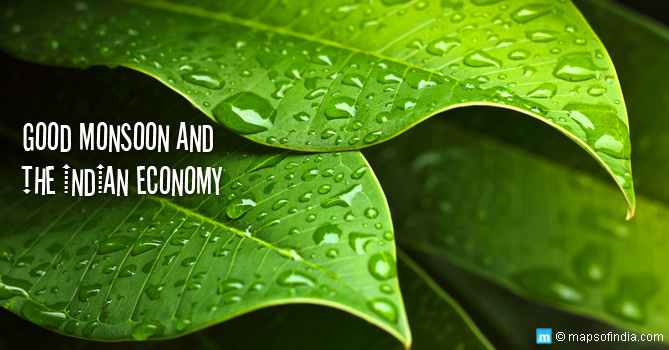IMD Predicts A Good Monsoon for 2016
After two long years of deficient rainfall contributed by the El Nino effect, the farmers of India may at last have reason to cheer. The India Meteorological Department (IMD) has issued a prediction of an above average rainfall this monsoon season. If the predictions are accurate, the agricultural sector of India is set for a big boost.
According to the IMD, the monsoons in India lasts for four months between June and September and in 2017 these months will see about 106 percent of the rain as determined by the LPA (long period average) – the average rainfall received by the country between the years 1951 and 2001. The IMD says that average rainfall during monsoon months according to the LPA is 89 cm and this year this is likely to go up to 94 cm. The IMD says its prediction has a 94 possibility of being realised. Before the IMD came up with its prediction, the Indian Institute of Tropical Meteorology (IITM) based in Pune also announced that India may expect an additional 10 mm rainfall each day this monsoon season.
In 2014, the monsoons only produced 88 percent of the LPA and in 2015, about 86 percent of the LPA. The last time India experienced drought conditions for two consecutive years was in 1986 and 1987.
Agriculture May Receive Boost
After two seasons of sub-normal monsoon, even an average rainy season, leave alone a very good one, sounds like good news. Indian farmers should expect a bumper crop. Agriculture is one of the major sectors of the Indian economy and contributes almost 16 percent to the nation’s GDP (gross domestic produce) and this could significantly contribute to the country’s economic growth.
A number of regions in the country are suffering from drought. Marathwada is a well-known example but almost 40 percent of the country’s population is currently reeling under the effects of severe drought. Farmer suicides due to failed crops and due to crop damage have increased over the past couple of years. A normal monsoon is likely to bring relief to the 60 percent population that is employed by the agricultural sector of the country. Only about 40 percent of the total cultivable land in the country is under irrigation and the remaining 60 percent is dependent on rainwater.
Effect on National Economy
Predictions of a good monsoon are certainly great news for Indian economy watchers. According to a recent research report by the State Bank of India, “We believe the agricultural GDP is most likely to witness a robust performance in 2016-17 and may even touch 7-8 per cent mark because of IMD projections amid the government’s plan to lift agriculture sector”. While Finance Minister, Arun Jaitley seemed overly optimistic about India’s economic growth following a good monsoon (he predicted an 8.5 percent growth), the Economic Survey of India is modest in its estimate and suggests a 7-7.75 percent growth for FY 2016-17. Despite the conservative estimate this is heartening, especially when one considers the grim global scenario. India has already established itself as the world’s fastest growing large economy, overtaking China.
Traditionally, inflation has been India’s biggest worry. Low oil prices have, however, aided India in its battle against inflation and both the CPI and WPI are quite low. A good monsoon and consequent boost to agricultural production is likely to further contain inflation and food prices. This means that India’s central bank, the RBI will be able to cut down its lending rates by up to 50 basis points, a news that promises to be heartening for India Inc.
Industries Likely To Pick Up
Industries that stand to gain most from a boom in agriculture are those that have a vested stake in the development of rural India. Fast moving consumer goods and packaged food companies stand to gain most. Companies such as Nestle, Britannia, ITC, GSK Consumer, Godrej derive most of their raw materials from agricultural produce. Lower costs are likely to increase profits. Companies such as Godrej and HUL too stand to gain considerably from a rapidly expanding agricultural sector. These will be the stocks to watch out for in Q3 of FY17 given a good monsoon.
Another look at the scenario reveals that good monsoon years predict a boost in tractor and fertilizer sales. Mahindra & Mahindra and Escorts sales are to watch out for while on the fertilisers front Brahmaputra Valley Fertilizer Corporation, Chambal Fertilisers and Chemicals, Coromandel International, Deepak Fertilisers and Petrochemicals Corporation, Hindalco Industries, and Rashtriya Chemicals and Fertilizers are expected to do well. Swaraj Engines, a supplier of tractor engines, is also a prime stock for Q3. Apart from these, a number of companies supplying farm equipments and irrigation tools, rural financing corporations and banks, infrastructure companies, and the packaging industry may expect good returns.
Is Indian Economy Set For A Boom?
There are a number of factors apart from agricultural growth that are likely to affect the Indian economy. Despite an above-average monsoon, investors will do well to keep these in mind. While weakening El Nino conditions bring good tidings, Indian indices will be struggling to swim against the tide in a sluggish global economic scenario. China’s economic woes are likely to adversely affect other Asian indices. The unfinished fiscal tasks of the government such as the nationwide Goods and Services Tax are not likely to help. What is imperative at the moment is that the government holds out a transparent communication channel with the RBI and come up with a robust fiscal policy for the medium and long terms. In the short-term scenario, India would do well to increase reliance on indigenous production, cut down on exports, and fortify the economy against global downtrends as far as possible.





